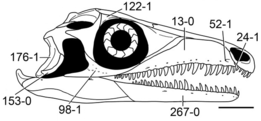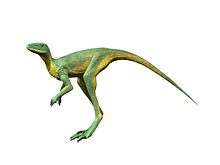Prolacerta
Prolacerta is a genus of archosauromorph from the lower Triassic of South Africa and Antarctica.[1][2] The only known species is Prolacerta broomi. The generic name Prolacerta is derived from Latin meaning “before lizard” and its species name broomi is in commemoration of the famous paleontologist Robert Broom, who discovered and studied many of the fossils found in rocks of the Karoo Supergroup. When first discovered, Prolacerta was considered to be ancestral to modern lizards, scientifically known as lacertilians.[3] However, a study by Gow (1975) instead found that it shared more similarities with the lineage that would lead to archosaurs such as crocodilians and dinosaurs (including birds). Prolacerta is considered by modern paleontologists to be among the closest relatives of the Archosauriformes.[1]
| Prolacerta | |
|---|---|
 | |
| The skull of Prolacerta broomi | |
| Scientific classification | |
| Kingdom: | Animalia |
| Phylum: | Chordata |
| Class: | Reptilia |
| Clade: | Archosauromorpha |
| Clade: | Crocopoda |
| Family: | †Prolacertidae |
| Genus: | †Prolacerta Parrington, 1935 |
| Species: | †P. broomi |
| Binomial name | |
| †Prolacerta broomi Parrington, 1935 | |
History of discovery
Prolacerta was first described by Francis Rex Parrington in 1935 from a single skull recovered near the small town, Middelburg, in the Eastern Cape of South Africa. The fossil was recovered from an exposure of rock from the Katberg Formation in the Lystrosaurus Assemblage Zone. At the time, Parrington described the first Prolacerta fossil, the early evolutionary relationships of archosaurs was even more poorly understood than they are currently. Due to its small size and lizard-like appearance, Parrington subsequently placed Prolacerta between basal younginids and modern lizards.[3] Parrington's classification of Prolacerta was accepted for several decades, including by the paleontologist Charles Lewis Camp who conducted further research on Prolacerta.[4][5] It was only after more Prolacerta fossils were found that more in depth research was undertaken on this animal. In the 1970s the close link between Prolacerta and crown archosaurs was first hypothesized,[6] which lead to numerous phylogenetic analyses being conducted on Prolacerta and other stem archosaurs from the 1980s onwards.[7][8][9][10][11][12][13][14]
Description

Prolacerta were small reptiles that lived during the Induan and Olenekian stages of the lower Triassic. Prolacerta is arguably the most well-represented stem-archosauriform, with numerous well preserved specimens housed in various research institutions in South Africa, Europe, and in the United States. With the skull of adult specimens ranging between 8 – 10 cm in length, Prolacerta were considered to have been small, lizard-like animals. However, several cranial and postcranial features set Prolacerta apart from lizards and instead show that it is an early relative of crown-archosaurs. Some of these notable features include elongated cervical vertebrae with elongate, thickened neural spines, which gave Prolacerta a slightly elongated neck and a wide range of flexibility.[15] Cranial features include thecodont teeth, a feature observed in all ancestors of crown archosaurs, which were pointed and caniniform in shape.
Prolacerta was probably a small, active, terrestrial carnivore or insectivore due to its fang-like teeth of roughly the same size and shape. Prolacerta is considered to have been a quadruped, although due to its hind limbs being larger and longer than its front limbs, there is a possibility that it was habitually bipedal during high activity.[6] It has been hypothesized that Prolacerta was capable of cranial kinesis, although research into this possible feature of Prolacerta remains inconclusive.
Classification
Initially hypothesized to be ancestral to lizards, Prolacerta was later identified as an archosauromorph by Gow (1975). Gow placed it into a group known as the Prolacertiformes, which also contained "protorosaurs" such as Protorosaurus, Macrocnemus, and the long-necked tanystropheids. Macrocnemus and a few other "prolacertiforms" were allied with Prolacerta in the family Prolacertidae.[6] However, later studies starting with Dilkes (1998) have split apart the concept of Prolacertiformes, with protorosaurs being placed near the base of Archosauromorpha and Prolacerta being much closer to Archosauriformes. Prolacertidae was also split by this reassessment, with Macrocnemus now considered a tanystropheid.[9] Currently, Prolacertidae is restricted to Prolacerta and its close Australian cousin Kadimakara. Prolacertids are confidently considered to be archosauromorphs within the clade Crocopoda, along with the allokotosaurs, rhynchosaurs, and archosauriforms.[1]
The following cladogram is based on a large analysis of archosauriforms published by M.D. Ezcurra in 2016
| Sauria |
| ||||||||||||||||||||||||||||||||||||||||||||||||||||||||||||||||||||||||
References
- Ezcurra, Martín D. (2016-04-28). "The phylogenetic relationships of basal archosauromorphs, with an emphasis on the systematics of proterosuchian archosauriforms". PeerJ. 4: e1778. doi:10.7717/peerj.1778. ISSN 2167-8359. PMC 4860341. PMID 27162705.
- Sengupta, Saradee; Ezcurra, Martín D.; Bandyopadhyay, Saswati (2017-08-21). "A new horned and long-necked herbivorous stem-archosaur from the Middle Triassic of India". Scientific Reports. 7 (1): 8366. Bibcode:2017NatSR...7.8366S. doi:10.1038/s41598-017-08658-8. ISSN 2045-2322. PMC 5567049. PMID 28827583.
- Parrington, F.R. (1935-08-01). "XVI.—On Prolacerta broomi, gen. et sp. n., and the origin of lizards". Annals and Magazine of Natural History. 16 (92): 197–205. doi:10.1080/00222933508655037. ISSN 0374-5481.
- Camp, Charles L. (1945-01-01). "Prolacerta and the protorosaurian reptiles; Part I". American Journal of Science. 243 (1): 17–32. Bibcode:1945AmJS..243...17C. doi:10.2475/ajs.243.1.17. ISSN 0002-9599.
- Camp, Charles L. (1945-02-01). "Prolacerta and the protosaurian reptiles; Part II". American Journal of Science. 243 (2): 84–101. Bibcode:1945AmJS..243...84C. doi:10.2475/ajs.243.2.84. ISSN 0002-9599.
- E, Gow, Chris (1975). "The morphology and relationships of Youngina capensis Broom and Prolacerta broomi Parrington". ISSN 0078-8554. Cite journal requires
|journal=(help) - SE, Evans (1986). "The braincase of Prolacerta broomi (Reptilia: Triassic)". Neues Jahrbuch für Geologie und Paläontologie - Abhandlungen. 173: 181–200. Retrieved 2018-11-22.
- 1905-, Colbert, Edwin Harris (1987). "The Triassic reptile Prolacerta in Antarctica. American Museum novitates ; no. 2882". hdl:2246/5211. Cite journal requires
|journal=(help)CS1 maint: numeric names: authors list (link) - Dilkes, David W. (1998-04-29). "The early Triassic rhynchosaur Mesosuchus browni and the interrelationships of basal archosauromorph reptiles". Philosophical Transactions of the Royal Society B: Biological Sciences. 353 (1368): 501–541. doi:10.1098/rstb.1998.0225. ISSN 0962-8436. PMC 1692244.
- Groenewald, G.H. and Kitching, J.W., 1995. Biostratigraphy of the Lystrosaurus assemblage zone. In Biostratigraphy of the Beaufort Group (Karoo Supergroup) (Vol. 1, pp. 35-39). Pretoria: Council for Geosciences.
- MODESTO, SEAN P.; SUES, HANS-DIETER (2004-02-24). "The skull of the Early Triassic archosauromorph reptile Prolacerta broomi and its phylogenetic significance". Zoological Journal of the Linnean Society. 140 (3): 335–351. doi:10.1111/j.1096-3642.2003.00102.x. ISSN 1096-3642.
- Nesbitt, Sterling J. (2011-04-29). "The Early Evolution of Archosaurs: Relationships and the Origin of Major Clades". Bulletin of the American Museum of Natural History. 352: 1–292. doi:10.1206/352.1. hdl:2246/6112. ISSN 0003-0090.
- Ezcurra, Martín D.; Scheyer, Torsten M.; Butler, Richard J. (2014-02-27). "The Origin and Early Evolution of Sauria: Reassessing the Permian Saurian Fossil Record and the Timing of the Crocodile-Lizard Divergence". PLoS ONE. 9 (2): e89165. Bibcode:2014PLoSO...989165E. doi:10.1371/journal.pone.0089165. ISSN 1932-6203. PMC 3937355. PMID 24586565.
- Sobral, Gabriela; Sookias, Roland B.; Bhullar, Bhart-Anjan S.; Smith, Roger; Butler, Richard J.; Müller, Johannes (2016-07-01). "New information on the braincase and inner ear of Euparkeria capensis Broom: implications for diapsid and archosaur evolution". Open Science. 3 (7): 160072. Bibcode:2016RSOS....360072S. doi:10.1098/rsos.160072. ISSN 2054-5703. PMC 4968458. PMID 27493766.
- Botha-Brink, Jennifer; Smith, Roger M. H. (2011-11-01). "Osteohistology of the Triassic archosauromorphsProlacerta,Proterosuchus,Euparkeria, andErythrosuchusfrom the Karoo Basin of South Africa". Journal of Vertebrate Paleontology. 31 (6): 1238–1254. doi:10.1080/02724634.2011.621797. ISSN 0272-4634.
_(Varanus_griseus).png)









